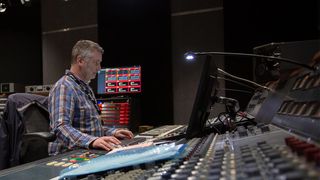The Marshall Studio is a state-of-the-art recording and mixing facility in Keynes, and there are many reasons to book some studio time there.
One reason might be its mixing desk, a restored Neve 8048 that the Rolling Stones used to track Some Girls.
Another might be its collection of guitar amps, which, as you might imagine from a studio owned and managed by Marshall Amplification, comprises every model in its current lineup, a huge range of vintage pieces, and a number of super-rare amps available on demand from the Marshall Museum. You’re also allowed to bring your own.
Guitarist Magazine’s editor, Jamie Dickson, and trusted lieutenants Neville Marten and Richard Barrett were offered a guided tour of the studio in the company of studio manager Adam Beer and Blake Nevitt, a Neve restoration specialist who sourced the studio’s desk and made it seaworthy again.

As Blake explains, the desk has enjoyed a storied history, having first been owned Studio Pathé Marconi in Paris, where the Stones used it while recording Some Girls with Chris Kimsey. But it was then was purchased by a Japanese bass player who wanted to use its EQ units, before it was found languishing in a warehouse in Burbank, California. Blake says he brought it to the country eight years ago and has been working on it ever since.
“I have just done loads of mods to it,” says Black. “I’ve speeded it up. It’s a lot faster desk than it was, so it sounds more like an 8068 in its speed. Guitars have that edge now, and drums have that speed where your overheads just sound incredible. You immediately want to put them on the kick and snare. It is making recording here so easy. You just bung up a nice pair of microphones in the right place.”
But to get a good sound you need some good amps, and to show you what’s possible when you have every Marshall available under the sun, Dickson and co grabbed a bunch of guitars and set about recording a track over eight hours that referenced key periods in nearly 60 of the brand's history.

The first part of the track references Eric Clapton and Cream, with Marten using a Telecaster, a Fulltone OCD and Cry Baby Jr into a Marshall 1974X tube combo. The second enters into a Little Wing-style Hendrix section, with Dickson putting a Fender Custom Shop Strat into a hand-wired 1959 100-watt Plexi and out through a Marshall 1960BHW 4x12.
“Obviously, the thing to do when you have got a studio like this, where you can turn up as loud as you like, is to dime the amp,” says Dickson. “Which is what we ended up doing.”
Dickson used a J Rockett Tranquilizer for that Phase 45/Uni-Vibe sound, but it was the pedal’s onboard preamp providing the secret sauce.
And finally, part three brought those ‘70s Ritchie Blackmore and Thin Lizzy early hard rock sounds online via a Knaggs singlecut, a Keeley Modded Boss SD-1 Super Overdrive, a Marshall JTM45THW head and 1960BX cabinet.
Tune in for guitar harmonies, leads, some impeccable playing and sweet tones, and plenty of food for thought when it comes to your next tube amp purchase.

